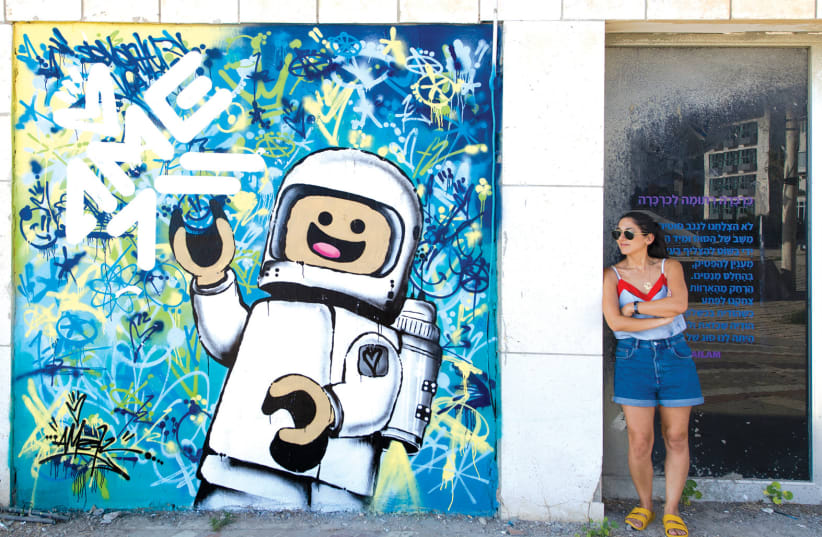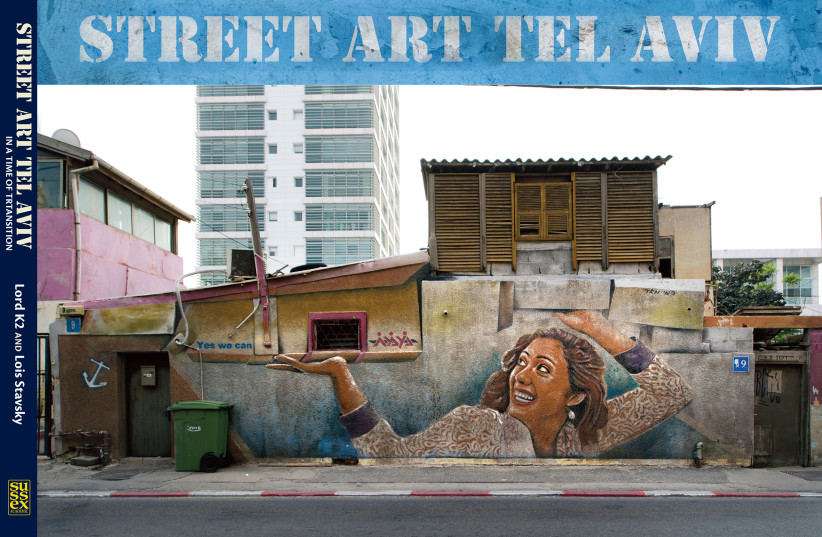I love street art – especially in Tel Aviv, where it is always eye catching, vibrant, thought provoking and unique.
There is some confusion between street art and graffiti, with a tendency by the latter to be more intense, more politically oriented and, sometimes, more violent and vandalistic in its attempts to express an idea or a protest. Israeli street art is special in that it represents a broad spectrum of cultural backgrounds and aesthetic sensibilities.
Tel Aviv street art, in particular, is individual, inventive and energetic, possessing a rawness and authenticity absent from much of the street art that surfaces in most modern cities across the globe. This suits a multi-cultural society such as Israel.
The book Street Art Tel Aviv by Lord K2 and Lois Stavsky was published some six weeks ago, by the UK publisher, Sussex Academic Press and I first learned of this beautiful book in a letter I received from the publisher, in the course of negotiating the sale of an English translation of a book I am working on.
The letter ended with a list of current and upcoming Sussex publications, which impressed me. The book under discussion here, by a young Englishman, caught my eye because of its colorful and intriguing cover as well as the fact that it was so different from the usual catalogue of Sussex publications. Sussex is known as a publisher of academic books, many of which deal with the Middle East and Jewish social and military history. Everything I subsequently learned about the book fascinated me and I was further impressed by the articulate and enlightened text, written by Lois Stavsky who shares credit for the book.
The cover of the book, created by the iconic street artist, Rami Meiri, depicts a mural of a woman, her head, shoulders and hands surfacing from out of a pavement in the seam between modern Tel Aviv and ancient Jaffa, her hands propping up bricks in a tumble down wall, against a background of one of Tel Aviv’s many new skyscrapers. Meiri had begun to transform the city’s stark walls into captivating canvases in 1980, but it wasn’t until the early 21st century that modern street art began to take hold throughout Tel Aviv and was mostly the work of young immigrants
I met Lord K2, via Face Time, some weeks ago when I spent an hour interviewing him. He is an award winning photographer with a huge passion for urban art. As well as Street Art Tel Aviv, he authored the well received Street Art Santiago (Schiffer, 2015) and Tokyo Graffiti (Schiffer, 2018), He is also the curator of the online Museum of Urban Art that he founded in 2014. His co-writer Lois Stavsky is an educator and oral historian of some repute, having gained international recognition for her documentation of global street art and popular blog, StreetArtNYC.org. In addition she curated the first US exhibition which featured Israeli street artists back in 2006 at New York University’s Bronfman Center.
David Sharabani (he prefers to be known by the name Lord K2) is a charming young English Jew, born and raised in Hammersmith London at a time when the Jewish population of that Borough was very small. He attended a state school and was later sent to a Jewish school much to his dismay since he viewed it as a bubble devoid of British culture..
David Sharabani’s parents live in Israel, although they are not originally from here. They left Israel in the late 60’s (before he was born) to live in London and returned seven years ago, when they settled in Tel Aviv, to be close to their daughter, who had already made the move. At that time David chose to remain in London. He sees himself as a man who belongs everywhere and nowhere, a peace loving man of the world. He is currently living and working in Barcelona.
When he was 17 years old and living in London, he received call up papers to the Israel Defense Forces and, after discussing the matter at great length with his parents, the family agreed that it would be better for him to stay put and focus on his education.
At one point, however, he did consider the idea of volunteering for some kind of partial military service in the IDF. They offer several programs for young Jews from the Diaspora, in the hope that they will be inspired to make aliyah. One of these is a three month para-military program, which appealed to Lord K2 and he made several attempts to sign up for it, including a number of visits to the recruitment office, which is located in London’s Golders Green neighborhood. Unfortunately, every time he turned up at the address full of enthusiasm and a desire to do his bit and volunteer for a term of military service in the Israel Defense Forces, the offices were closed. Discouraged, he decided to drop the idea.
As he says: “Conventional life doesn’t appeal to me, I have always been drawn to discovering and exploring different cultures; and I believe in enjoying the precious little time life has to offer me.
“To achieve this I needed financial freedom. It occurred to me, therefore that if I were to trade the stock market through my laptop and phone I would be able to earn enough and have the freedom to travel all over the world. Although the doom-mongers were quick to point out to me that 96% of all traders lose money, the only thing that I was focused on was putting some of that remaining 4% in my own pocket. It took me two years of intensive and quite enjoyable reading and researching before I was ready to go.
“Nine years later, I realized that I had accumulated enough money to enable me to live well, to travel as I wished and to still have some change left over to put away for the future. I then had a desire for a new challenge. It was in Buenos Aires that I became drawn towards street art. I decided to pause my trading and focus on painting on walls; however, a few months into painting I realized that I actually preferred to photograph and document others people’s paint on walls.”
This led to the publication of his first book: the acclaimed Street Art Santiago, which was followed in 2018 by Tokyo Graffiti. The photographer’s path was set.
The book’s photographed illustrations are all produced immaculately. Lois Stavsky, who is very much into the street art scene, was his choice to co-write the text while he focused on documenting the works before they were washed away into oblivion. The two work very well together, each complementing the other’s methods. Readers of the book can see for themselves the wonderful results of this cooperation.
Today, he lives and works in Barcelona and is currently working on a book on New York street art (which is to be published by Swedish publisher, Dokument Press).
This book, again, is being produced in coordination with Lois Stavsky, who writes the text for all his books. They are an exceptional team; he applauds her writing and she knows that her words support superb images.
“In addition to photographing urban art, Lord K2 has extensively documented the culture and lifestyle of Muay Thai in Thailand. He photographed for the World Muay Thai Council and for the International Federation of Muay Thai Amateur. His work has been featured on the front cover of Asian Geographic, as well as in numerous news media. In documenting Sumo culture in Japan, he has been granted rare permission to photograph the wrestlers in their stables and in the Kokugikan Stadium. He bides his time over these projects, spending many years investigating their inner workings before fully releasing his works to the public.” (Lois Stavsky).
In Israel, Street Art Tel Aviv is currently available in Tel Aviv’s Bauhaus Center and attempts are being made to find it a wider audience in Israeli museum shops. A Hebrew translation is also being considered.
Lord K2’s experience has taught him that it’s not at all easy to find a major international publisher even for an uncontroversial book about Israel, because of global anti-Israel sentiment; it is as if many publishers, influenced by BDS and other anti-Israel organizations, deliberately go to great lengths to sabotage publication of anything to do with Israel, even if the subject is as innocent as a beautiful book about art on the streets of Tel Aviv. Lord K2 is very grateful to Sussex Academic Press, which has published numerous books on Israel and had no problems about taking on this extraordinary art book.

